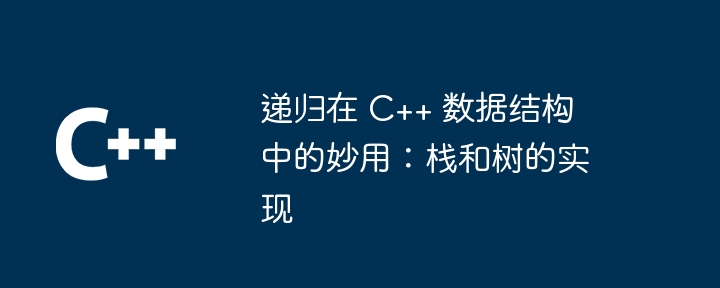遞歸在 C++ 資料結構中的妙用:棧和樹的實現
遞歸在 C 資料結構中的應用:堆疊:透過後進先出 (LIFO) 結構遞歸實作堆疊。樹:透過分層結構遞歸實現樹,支援插入和深度計算等操作。遞歸為處理巢狀結構提供了簡潔且有效率的解決方案,使資料結構的實作更加直覺且易於維護。

遞歸在C 資料結構中的妙用:堆疊和樹的實作
遞歸是一種強大的程式設計技術,它允許函數呼叫自身來解決問題。在資料結構的實作中,遞歸非常有用,特別是對於處理樹狀結構和線形結構。
堆疊的遞歸實作
#堆疊是一種後進先出 (LIFO) 資料結構。我們可以使用遞歸實作棧,如下所示:
struct Node {
int data;
Node* next;
};
class Stack {
private:
Node* head;
public:
void push(int data) {
head = new Node{data, head};
}
int pop() {
if (head == nullptr) {
throw exception("Stack is empty");
}
int data = head->data;
head = head->next;
return data;
}
bool empty() {
return head == nullptr;
}
};#實戰案例:逆序列印鍊錶
void printLinkedListInReverseOrder(Node* head) {
if (head == nullptr) {
return;
}
printLinkedListInReverseOrder(head->next);
cout << head->data << " ";
}樹的遞歸實作
#樹是一種分層資料結構。我們可以使用遞歸來實現樹,如下所示:
struct Node {
int data;
vector<Node*> children;
};
class Tree {
private:
Node* root;
public:
void insert(int data) {
if (root == nullptr) {
root = new Node{data, {}};
} else {
insertHelper(root, data);
}
}
private:
void insertHelper(Node* node, int data) {
for (auto& child : node->children) {
if (child == nullptr) {
child = new Node{data, {}};
return;
}
}
node->children.push_back(new Node{data, {}});
}
void printTree() {
printTreeHelper(root);
}
private:
void printTreeHelper(Node* node) {
cout << node->data << " ";
for (auto& child : node->children) {
printTreeHelper(child);
}
}
};#實戰案例:計算二元樹的深度
int calculateTreeDepth(Node* root) {
if (root == nullptr) {
return 0;
}
int maxDepth = 0;
for (auto& child : root->children) {
maxDepth = max(maxDepth, calculateTreeDepth(child));
}
return maxDepth + 1;
}透過遞歸,我們可以簡潔高效地實現堆疊和樹等關鍵資料結構。遞歸為處理複雜巢狀結構提供了強大的工具,使資料結構的實作變得更加直觀和易於維護。
以上是遞歸在 C++ 資料結構中的妙用:棧和樹的實現的詳細內容。更多資訊請關注PHP中文網其他相關文章!

熱AI工具

Undresser.AI Undress
人工智慧驅動的應用程序,用於創建逼真的裸體照片

AI Clothes Remover
用於從照片中去除衣服的線上人工智慧工具。

Undress AI Tool
免費脫衣圖片

Clothoff.io
AI脫衣器

Video Face Swap
使用我們完全免費的人工智慧換臉工具,輕鬆在任何影片中換臉!

熱門文章

熱工具

記事本++7.3.1
好用且免費的程式碼編輯器

SublimeText3漢化版
中文版,非常好用

禪工作室 13.0.1
強大的PHP整合開發環境

Dreamweaver CS6
視覺化網頁開發工具

SublimeText3 Mac版
神級程式碼編輯軟體(SublimeText3)
 C#與C:歷史,進化和未來前景
Apr 19, 2025 am 12:07 AM
C#與C:歷史,進化和未來前景
Apr 19, 2025 am 12:07 AM
C#和C 的歷史與演變各有特色,未來前景也不同。 1.C 由BjarneStroustrup在1983年發明,旨在將面向對象編程引入C語言,其演變歷程包括多次標準化,如C 11引入auto關鍵字和lambda表達式,C 20引入概念和協程,未來將專注於性能和系統級編程。 2.C#由微軟在2000年發布,結合C 和Java的優點,其演變注重簡潔性和生產力,如C#2.0引入泛型,C#5.0引入異步編程,未來將專注於開發者的生產力和雲計算。
 vscode在哪寫代碼
Apr 15, 2025 pm 09:54 PM
vscode在哪寫代碼
Apr 15, 2025 pm 09:54 PM
在 Visual Studio Code(VSCode)中編寫代碼簡單易行,只需安裝 VSCode、創建項目、選擇語言、創建文件、編寫代碼、保存並運行即可。 VSCode 的優點包括跨平台、免費開源、強大功能、擴展豐富,以及輕量快速。
 Golang和C:並發與原始速度
Apr 21, 2025 am 12:16 AM
Golang和C:並發與原始速度
Apr 21, 2025 am 12:16 AM
Golang在並發性上優於C ,而C 在原始速度上優於Golang。 1)Golang通過goroutine和channel實現高效並發,適合處理大量並發任務。 2)C 通過編譯器優化和標準庫,提供接近硬件的高性能,適合需要極致優化的應用。
 表演競賽:Golang vs.C
Apr 16, 2025 am 12:07 AM
表演競賽:Golang vs.C
Apr 16, 2025 am 12:07 AM
Golang和C 在性能競賽中的表現各有優勢:1)Golang適合高並發和快速開發,2)C 提供更高性能和細粒度控制。選擇應基於項目需求和團隊技術棧。
 Golang和C:性能的權衡
Apr 17, 2025 am 12:18 AM
Golang和C:性能的權衡
Apr 17, 2025 am 12:18 AM
Golang和C 在性能上的差異主要體現在內存管理、編譯優化和運行時效率等方面。 1)Golang的垃圾回收機制方便但可能影響性能,2)C 的手動內存管理和編譯器優化在遞歸計算中表現更為高效。
 Python與C:學習曲線和易用性
Apr 19, 2025 am 12:20 AM
Python與C:學習曲線和易用性
Apr 19, 2025 am 12:20 AM
Python更易學且易用,C 則更強大但複雜。 1.Python語法簡潔,適合初學者,動態類型和自動內存管理使其易用,但可能導致運行時錯誤。 2.C 提供低級控制和高級特性,適合高性能應用,但學習門檻高,需手動管理內存和類型安全。
 vscode如何執行代碼
Apr 15, 2025 pm 09:51 PM
vscode如何執行代碼
Apr 15, 2025 pm 09:51 PM
在 VS Code 中執行代碼只需六個步驟:1. 打開項目;2. 創建和編寫代碼文件;3. 打開終端;4. 導航到項目目錄;5. 使用適當的命令執行代碼;6. 查看輸出。
 VSCode怎麼用
Apr 15, 2025 pm 11:21 PM
VSCode怎麼用
Apr 15, 2025 pm 11:21 PM
Visual Studio Code (VSCode) 是一款跨平台、開源且免費的代碼編輯器,由微軟開發。它以輕量、可擴展性和對眾多編程語言的支持而著稱。要安裝 VSCode,請訪問官方網站下載並運行安裝程序。使用 VSCode 時,可以創建新項目、編輯代碼、調試代碼、導航項目、擴展 VSCode 和管理設置。 VSCode 適用於 Windows、macOS 和 Linux,支持多種編程語言,並通過 Marketplace 提供各種擴展。它的優勢包括輕量、可擴展性、廣泛的語言支持、豐富的功能和版






